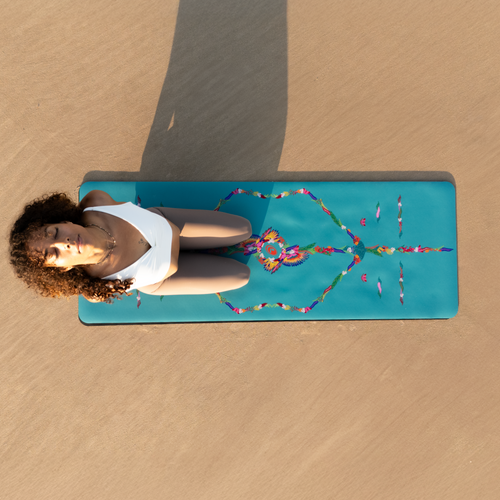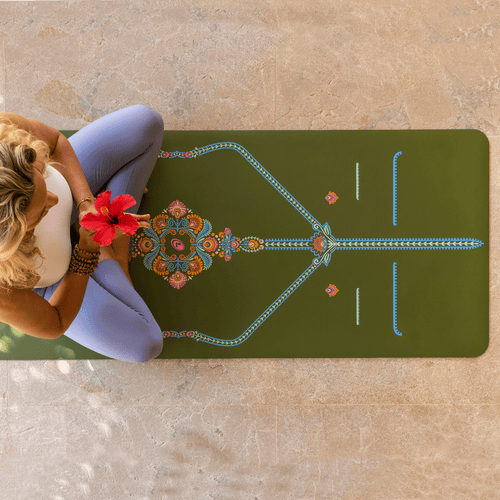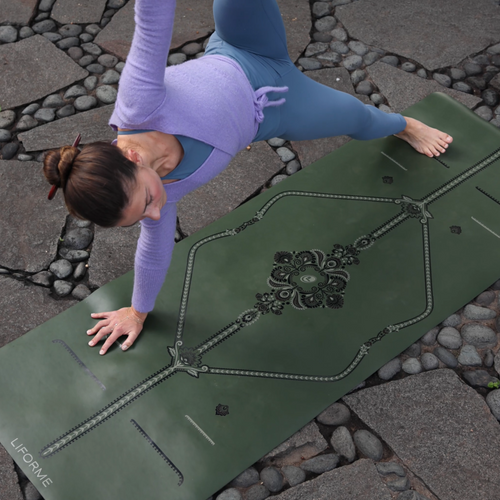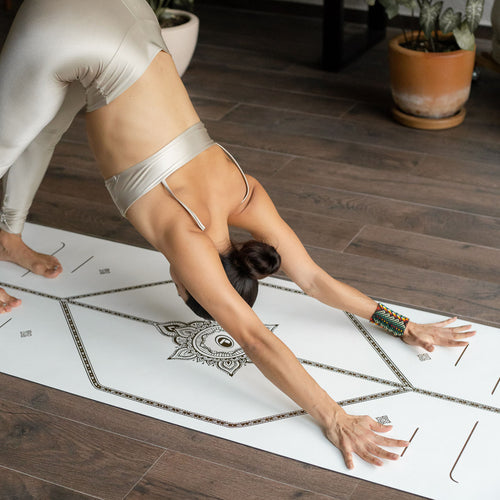Stress is so intrinsic to modern life that trying to counteract it helps power the colossal health and wellness industry. Tea, exercise, journaling, meditation, retreats, and everything else that sits under the self-care umbrella can all contribute to lowering your stress levels.
But there’s something else you can do to fight stress, something so simple that it may not even be on your radar. We’re talking about… (drum roll, please) going outside!
That’s a bit of an oversimplification but immersing yourself in nature really does measurably lower stress. Studies have shown that the Japanese practice of shinrin-yoku or ‘forest bathing’ lowers stress hormones. And just imagine if you add yoga into the picture…
Well, we did! Taking your practice outside has the potential to combine the stress-busting powers of Yoga and forest bathing for a real mental reset. Let’s get into the weeds, so to speak, and find out more.
What Is Forest Bathing?
Shinrin-yoku, which means taking in the atmosphere of the forest, emerged in the 1980s in Japan as an antidote to an increasingly high-tech world and a way to foster a connection with nature and encourage the desire to preserve it. The practice was quickly embraced in Japan and then around the world.
Spending time immersed in a wholly natural environment helps you disconnect from the pressures of city life, work, and constant interactions with technology. Researchers theorize that being in nature is comfortable for humans because we lived in these types of environments for most of our history.
A 2010 study compared stress markers when groups of participants spent 15-30 minutes in a forest vs when they spent the same amount of time in an urban setting.
The forest group had measurably lower levels of the stress hormone cortisol, lower pulse rates, lower blood pressure, greater parasympathetic nerve activity (rest and digest), and lower sympathetic nerve activity (fight or flight).
Lower stress levels in turn lead to a stronger immune system, a healthier cardio-vascular system, and better mental and physical health overall.

Benefits of Outdoor Yoga
Outdoor yoga has many of the same benefits as forest bathing, especially if you can really take it into the wild. Even if you go into your back garden or a local park, you’ll be able to experience the benefits of unplugging and being outside.
Fresh air, the sounds of birds and insects, the feel of the earth underfoot: all these sensations are very grounding and bring you into the present moment. And, just as the pioneers of forest bathing suggested, forging a strong connection with nature makes us all into environmentalists with strong commitments toward preservation.
Stepping away from your computer, moving your body, and getting some Vitamin D are natural ways to clear your mind, change your perspective, and reduce anxiety. Doing some Sun Salutations in the grass ticks all these boxes.
How to Combine Forest Bathing and Outdoor Yoga
Shinrin-yoku prescribes the setting but doesn’t specify what you should do there. While it’s great to sit or walk in nature, doing yoga practices, including asana, pranayama, and meditation, can deepen your connection to nature while providing even more stress relief.
Let’s look at an ideal scenario and ways to adapt if you don’t have access to a completely natural area.
Time: Plan on a minimum of 30 minutes, not including commuting time.
Location: If you live near a forest, you are all set, but many of us will need to be more flexible in finding our setting. In urban areas, seek out a large park, nature preserve, or greenway. Ideally, you will not be hearing traffic or seeing big groups of people. If there aren’t wooded areas nearby, expand your search to other natural environments. A beach, field, or hillside may work just as well.
What to bring: Bring your yoga mat and water bottle. Dress in layers for comfort. If you bring an extra layer, you can also use it to cushion and elevate your seat.
Yoga practices: Begin your yoga as soon as you enter the space by walking and breathing mindfully. Begin to notice your breath without changing anything. Bring your attention to the sounds around you, which you can use to separate your mind from your day-to-day concerns. Start to practice releasing your thoughts as they arise rather than engaging with them.
Yoga Poses to Enhance Your Forest Bathing Experience
Any poses that you feel called to are appropriate for outdoor yoga. If you’re not sure where to start, here are a few suggestions.

Child’s Pose (Balasana)
- From a hands-and-knees position, open your knees to the edges of your mat and bring your big toes to touch.
- Sink your butt back to rest on your heels while keeping your arms straight and stretching forward.
- Bring your forehead to your mat. Absorb the smell of the surrounding earth. Close your eyes to enhance your appreciation of the sounds of nature all around you.

Cobra (Bhujangasana)
- Lie on your stomach with your legs extended and your palms flat on your mat under your shoulders. Bend your elbows straight back and hug them into your sides.
- Take this full-body contact with the earth moment to notice how it feels to be on a natural surface instead of a smooth, regular floor. There may be bumps and that’s fine. Observe without judgement.
- On an inhalation, anchor your pelvis to the ground and lift your chest away from the floor without pressing into your hands.
- On an exhalation, lower your chest back down. Repeat this motion a few more times.

Goddess (Utkata Konasana)
- Come to stand facing the long side of your mat with your feet wide apart.
- Turn your toes out 45 degrees and bend your knees to bring your thighs toward parallel with the ground.
- Take your arms into any position that feels natural and move from side to side intuitively doing what feels good as you take in the environment around you.

Tree Pose (Vrksasana)
- Begin in Mountain Pose.
- Keeping your hips facing the front of your mat, shift your weight into your right leg and lift your left foot off the ground.
- Using your hands if necessary, place the sole of your left foot on the inside of your right thigh.
- Root into the sole of your right foot and lift your arms like branches.
- Repeat the posture standing on your left foot.

Easy Pose (Sukhasana)
- Come to sit in a comfortable cross-legged position.
- Bring your hands onto your thighs with the palms down for grounding or the palms up for receptivity.
- Choose to close your eyes to turn your attention inward or keep them open to take in the natural world around you.
- When thoughts arise, release them and let them float away like clouds.
Reduce Stress the Natural Way
So, the verdict is in. To destress the natural way, head outside. Immerse yourself in nature. Throw in a little movement and meditation and you’ll emerge feeling calmer and with new perspectives on what matters on our little blue and green planet.
Check out: Liforme Deep Forest Green Yoga Mat for a little bit of the forest wherever you are!





































